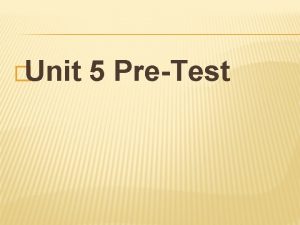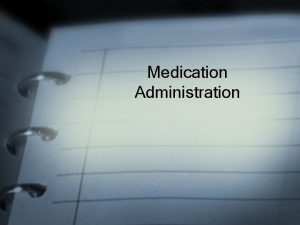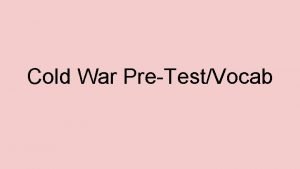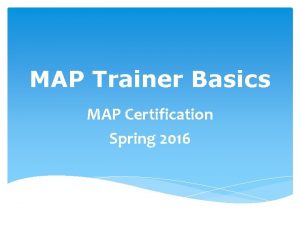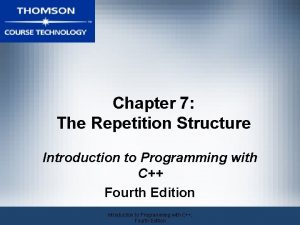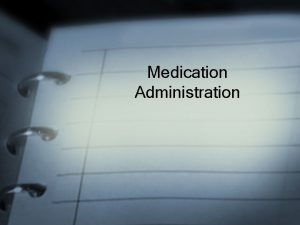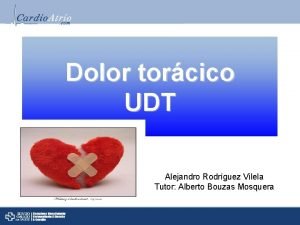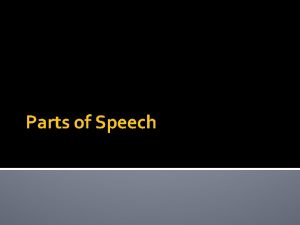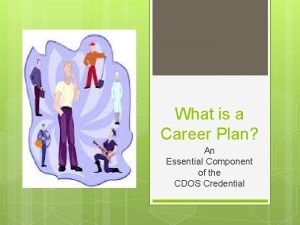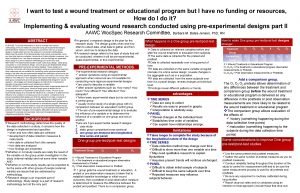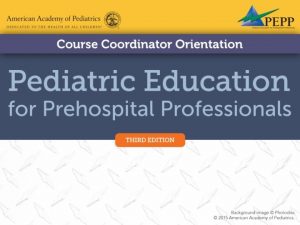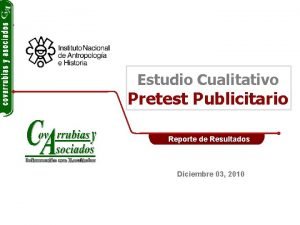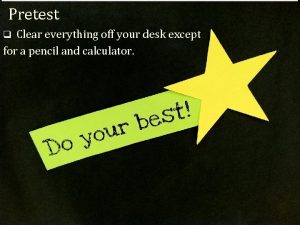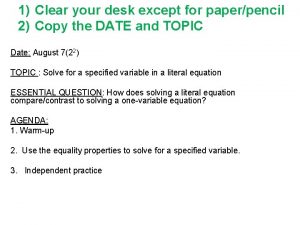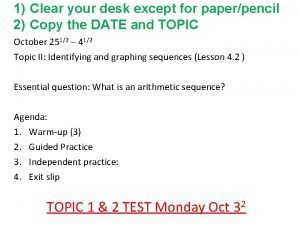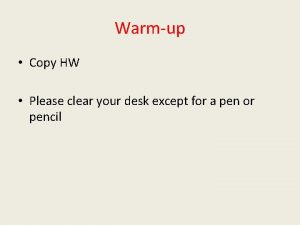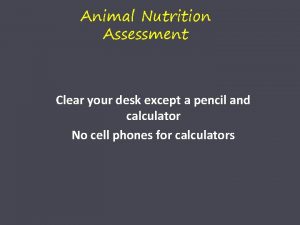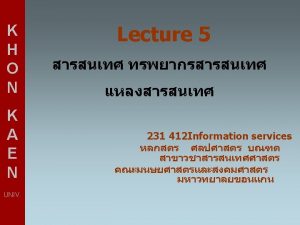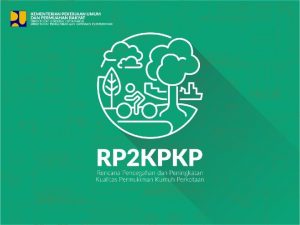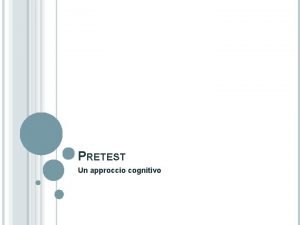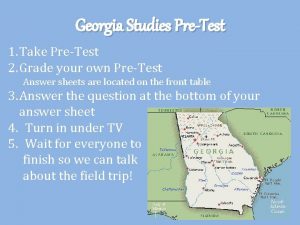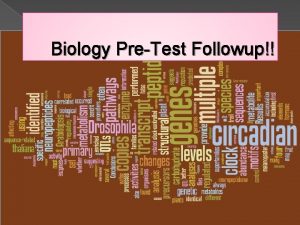PRETEST DIRECTIONS Clear desk except for a pencil






























- Slides: 30

PRETEST DIRECTIONS • Clear desk except for a pencil • Put up a divider (every other person) • There should be NO DEVICES in the room…if you have one, shut it down & put it in your locker now. • Take PRETEST…if you don’t know an answer, mark E. • Flip upside down when finished & read article provided (CLASS SET!!) • Be prepared to share an interesting/surprising thought from article

Organ Transplant Article • Be prepared to share one interesting or surprising thing you learned from the article aloud with the class. • Where did doctors get the stem cells that were used to build this windpipe? http: //www. bbc. com/news/health-14047670

Card Sort Activity Using the laminated cards provided at each group table, sort the terms into one of the categories listed on the colored cards. Discuss ideas with your group members…you must talk through each one! Compile your group ideas on the organizer provided…

What is a System? Think about the pen you may be holding. Does it have parts? Do they work together to do a job? Yes! A pen has the case, the tube that holds the ink, the ballpoint and it may even have an erasure if it contains erasable ink. If it clicks to open and close it will have a spring and a part to make the point go in and out. All of these parts work together so you can write with the pen. That makes it a system! So, a system is a group of parts that work together to perform a function. What is a function? The parts of a pen work together so you can write with it. That is its function. A function is the job a system performs.

Examples of Systems • What are the names of each part in this system and what function do they perform? • What would happen if the keyboard or mouse stopped working?

Examples of Systems • What are the names of each part in this system and what function do they perform? • What would happen if the engine stopped working?

Ticket out the Door- “Shout” Out • Think of your own example of something abiotic (non-living) that works together as a system. • What are the parts included in this system and what are their functions?

Mind Stretcher: 1/5/18 Write 2 examples of an ORGAN and 2 examples of ORGAN SYSTEMS… Possible Answers: Organs- heart, lungs, brain, skin, stomach, intestines, bones Organ Systems- circulatory, respiratory, nervous, integumentary, digestive…

GUIDELINES AND PROCEDURES REVIEW 1. Be in your assigned seat and working on the directions on the board (usually a mindstrecther) before the bell rings. 2. Bring ALL books and materials to class and take them with you when you leave. 3. Maximize learning time by staying focused and on task. 4. Treat each person in this room with respect and dignity. 5. When the teacher is talking – no one else is. 6. Not following these rules will have consequences.

BEHAVIOR PLAN 1. Redirection 2. Behavior mark and notify parent 3. Behavior mark, silent lunch, notify parent 4. Behavior mark, detention, notify parent 5. Referral and call parent 6. Behavior intervention

Levels of Organization Notes Please write TITLE of each slide and the green notes in each box on organizer

ATOMS • Smallest part of matter • NON-living

Molecules • 2 or more bonded atoms • Form compounds • NON-living

Macromolecule • Very large complex molecules (polymers) made of a bunch of smaller molecules that are the same (monomers. ) – Analogy If you have a pearl necklace. The individual pearls would be the monomer and the necklace would be the polymer. • All living things are made up of proteins, fats, carbohydrates, and nucleic acids. • NON-living

Organelles • “Tiny organs” • Made of macromolecules • Non-living Ex: nucleus, mitochondria

Cell • Made of organelles • Basic unit of structure & function • LIVING Ex: plant cell, skin cell…

Tissue • The SIMILAR cells working together • Living Ex: muscle tissue, nerve tissue

Organs • SIMILAR tissues that work together • Living Ex: heart, stomach…

Organ Systems • Organs that work together for similar purpose • Living Ex: skeletal system, nervous system

Organism • Entire living things (organisms) • Usually made of systems • May be a single cell • Living Ex: human, dog

Population • Same organisms living together Ex: group of penguins

Community • Several populations living together • Populations interact Ex: penguins, polar bears

Ecosystem • A biotic (living) community and the abiotic (nonliving) features Ex: penguins, polar bears, temperature, & sun

Biome • Similar ecosystems on earth together Ex: arctic tundra

Biosphere • Whole living layer on Earth • Includes abiotic features http: //people. hofstra. edu/geotrans/eng/ch 8 en/conc 8 en/envisys. html

Atom Molecule Macromolecule Organelle Cell Tissue Organ System Organism Population Community Ecosystem Biome Biosphere

Summary Statement on the bottom of organizer: • Look back at the title of these notes and think about how it was organized… • Write 1 -2 sentences summarizing what you just learned on this page.

Video Clip- Levels of Organization https: //www. youtube. com/watch? v=7 xp. ONWAj 4 Go

Reading Activity. The Organization of the Human Body • Read & follow directions on sheet provided

Think, Pair, Share: Can you put the following items in order from smallest to largest? Organ, Cell, Organ System, Tissue, Organism **Think to yourself first! Then quietly discuss with table partner…be ready for me to call on you to share!
 Slope of zero
Slope of zero Proxy pretest
Proxy pretest Injectable medication administration pretest
Injectable medication administration pretest Topic sentence test
Topic sentence test Pretest communism and the cold war
Pretest communism and the cold war Www hdmaster com map
Www hdmaster com map Repetition structure c++
Repetition structure c++ Injectable medication administration pretest
Injectable medication administration pretest Alejandro rodriguez vilela
Alejandro rodriguez vilela Parts of speech fill in the blanks
Parts of speech fill in the blanks Proxy pretest design
Proxy pretest design Pretest: developing an academic and career plan
Pretest: developing an academic and career plan Pretest art in the 20th century and today
Pretest art in the 20th century and today Pretest: growth, development, and sexuality
Pretest: growth, development, and sexuality Wound care pretest
Wound care pretest Pepp pretest
Pepp pretest The early and mid-nineteenth century: romanticism
The early and mid-nineteenth century: romanticism Pretest: the universe
Pretest: the universe Pretest publicitario ejemplo
Pretest publicitario ejemplo Atmosfr
Atmosfr Rutin för avvikelsehantering
Rutin för avvikelsehantering Vanlig celldelning
Vanlig celldelning Myndigheten för delaktighet
Myndigheten för delaktighet Presentera för publik crossboss
Presentera för publik crossboss Kung dog 1611
Kung dog 1611 Vad är densitet
Vad är densitet Hur skriver man en debattartikel
Hur skriver man en debattartikel Tobinskatten för och nackdelar
Tobinskatten för och nackdelar Nationell inriktning för artificiell intelligens
Nationell inriktning för artificiell intelligens Tack för att ni har lyssnat
Tack för att ni har lyssnat Referatmarkering
Referatmarkering
